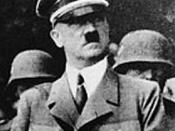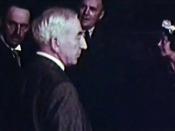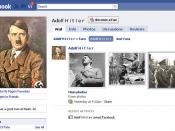James Carthew -15665084 Modern History Assessment 2
Good Afternoon Teachers and fellow students.
Today I will present to you the culmination of my research into the area of science and technology in Nazi Germany from 1933 to 1939. This aspect of life in Nazi Germany was to be of major significance to Hitler's vision for Germany and as my presentation will show, did provide some notable discoveries and developments. Initially, I will discuss the scientific climate of that period, followed by a summary of some of the more noteworthy innovations and scientific breakthroughs. This includes groundbreaking studies in the area of medicine through to rocketry and jet engines.
Interestingly, prior to Hitler's regime, Germany was seen as a 'Mecca' for scientific development, with many great scientists and Nobel Peace Prize winners originating there. Unfortunately, the period 1933 to 1939 saw this change as Anti-Semitism led to the expulsion of many great scientists.
For example Albert Einstein's theories were dismissed as "Jew Physics" and consequent studies in theoretical physics were terminated.
Other events such as the 12 May 1934 'book burning' only fuelled the decline in momentum of science in Germany.
In his autobiography 'Mein Kampf', Hitler explains the Nazi ideology of 'Gleichaltung' or 'marching in step'. Hitler further elucidates his belief that the advancement of scientific knowledge and technological understanding is to be 'an instrument of national pride' to further advance the 'Volkish state'. It is apparent then, that any advancement in science at this time was essentially a tool or device for Nazi propaganda.
The new Reich, 'Der Deutsche Tecknik' was designed to incorporate the principles of logic, strength, modernity and health. Hitler's science was therefore intended to meet these needs and strengthen Aryan superiority. This lead to substantial investigations in medicine and most notably Hitler's anti smoking campaigns. For the first time in history, smoking cigarettes was linked to cancer. Further studies in 1938 also identified asbestos as responsible for twelve strains of cancer. Jewish scientists involved in this research often changed their name and religion in their desire to continue their studies. Ironically, a prominent Jewish scientist Fritz Haber followed this path and is credited with the invention of Zyklon-B, used in gas chambers of termination camps! Another nerve agent called Tabun was also developed initially as an insecticide but later used for more sinister purposes.
May 1933 saw the development of the Volkesempfanger -the people's radio. This enabled Hitler's speeches to be transmitted live into German homes - a total of 50 speeches in 1933! By 1939, 70% of the German population owned a radio and was therefore subject to rampant Nazi propaganda.
The development of the Magnetophone - a reel to reel tape recorder- in 1935 by
Semi Joseph Begun was to be a significant scientific development and propaganda tool that enabled Hitler's speeches to be recorded and played over the radio numerous times. Similarly, advancements in television lead to coverage of the 1936 Berlin Olympics which was a source of great national pride.
The Volkswagen - the people's car - was another propaganda tool of the Nazi regime - Hitler promised every family a car and was therefore in favour of the development of an economically constructed vehicle. Hitler's policy of Autarky meant the Volkswagen was designed by German car company Porsche and was constructed as part of the public works program that sprung from the depression. The Volkswagen was released in 1939 and was to be produced at a rate of 1.5million a year before the war intervened.
The most famous development of the Nazi era was the development of the A2 rocket by Werner von Braun in 1934. This revolutionary rocket employed safeguard technology that hasn't changed since its conception and led to further research and advancements in aerodynamics and rocketry.
Other significant scientific achievements of the time were the discovery of nuclear fission in 1938 by Otto Hahn, the invention of the first programmable computer, Z1 by Konrad Zuse in 1938, and the development of jet propulsion and the first jet engine in 1936 by Hans von Ohain leading to the creation of the Heinkel He 176 in 1939 - the first rocket propelled, liquid fuelled plane. The German Navy is recognised as the pioneering force in their research of radar technology in 1935.
In conclusion, whilst the period 1933 to 1939 was certainly not the 'golden age' for science in Germany, it can still be credited with some importance that was fuelled by the policy of 'Gleischaltung' and improved national pride. As surmised by historian, John Cornwell in his book 'Hitler's Scientists' 'The Third Reich saw the misuse and misapplication of innovation, the loss of freedom and diversity, neglect and decline in some branches of natural sciences.' It is my opinion drawn from my readings and research that this is an accurate description of the aspect of science and technological advancements during this period of Nazi Germany.
�PAGE � �PAGE �1�





